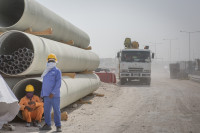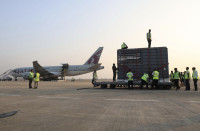Opinion
Chugging towards development
The trans-Himalayan railway must be built by mobilising political commitment
Nepal and China have agreed to prepare a detailed project report to build a much discussed railway line across the Himalaya connecting Kerung and Kathmandu. This decision comes at a time when the Chinese president recently announced that China was going to build a new railway line connecting Chengdu, Sichuan and Lhasa, Tibet. It was not a mere coincidence that Indian news website Hindustan Times reported that Indian Prime Minister Modi would be embarking on a fifth visit to Nepal in December to inaugurate a railway line between Nepal and India as ‘part of India’s efforts to counter China’s plans to forge rail links connecting the Himalayan country with Tibet’.
The railway geopolitics of the two giant economies is surfacing on the most difficult terrain in the world. Scarred by the recent Indian blockade, the Nepali people seem determined to see a railway running across the snow peaks as a symbol of national rejuvenation and pride. The Himalaya, the highest mountain range in the world, remains the most difficult, isolated and dangerous place for modern development. Building a railway line across the Himalaya was, therefore, unthinkable till recently.
Politically, it was unthinkable because any proposition to build such infrastructure would encounter readymade criticism of being a Chinese attempt to invade South Asia and an endeavour to expand communism in the Himalaya. Geographically, imagining a railway line across the Himalaya that would require a new level of technological mastery and economic investment would be farfetched in a relatively poor region of the world.
But thanks to the enormous technological knowhow and investment capability gained by China, this once unthinkable railway in the Himalaya is probably going to come true. As per a feasibility study, the 72-km Kerung-Kathmandu section will cost about $3 billion. The Himalayan railway project will definitely encounter geopolitical hurdles, which has been the case for Nepal every time it made an effort to open its border to China for the development of trans-border infrastructure. Nepal has faced three economic blockades by India—in 1962, 1989 and 2015—all aimed at ‘teaching Nepal a lesson’. The 2015 blockade generated a new national consensus to develop advanced connectivity with China. People firmly believed that the railway line would create a new frontier for international trade and connectivity. For a number of reasons, the trans-Himalayan railway must be built by mobilising the highest level of political commitment from both Nepal and China.
First, an overwhelming majority of Nepalis consider this proposed railway infrastructure as a ‘national liberation project’ that will help to secure national sovereignty and the people’s wellbeing. They hope that the Himalayan railway will link Nepal with the vast network of global connectivity as envisioned by the Belt and Road Initiative (BRI). The government of Nepal must take this sentiment of the people seriously. People firmly believe that the railway will help Nepal to resolve several issues related to trade and international connectivity, and most importantly, the Nepali people’s feeling of being a landlocked and deprived country.
Second, the trans-Himalayan railway project requires the highest level of technological sophistication to overcome the geological barriers. The railway project provides an enormous opportunity to improve technological skills related to high altitude slopes, seismic fault lines and rapid altitudinal variations. It will be a laboratory for advanced scientific and technological innovation on one of the most difficult terrains on earth.
Third, the historically vibrant, unique and vast Himalayan landscapes have been seriously undermined in the contemporary geopolitical situation, especially since the Cold War, and the entire Himalaya has been reduced to a borderland. The Himalayan railway will revitalise the vastness of the Himalaya and dismantle the long-standing myth of a buffer zone. It will help to conceptualise Himalayan prosperity with its own characteristics and uniqueness.
Fourth, the Himalayan ice is melting, jeopardising the lives of more than 2 billion people in Asia. The irony is that the Himalaya is not featured with priority in any global initiative on climate change. The railway project might highlight the region on a global scale and publicise its international importance to mitigate climate change induced devastations in the Himalaya. Finally, the Himalayan railway will eventually connect two historical civilisations and modern economic powerhouses on either side of the Himalaya. This may generate a new frontier of cooperation in an otherwise contested Himalayan landscape.
After a long political transition, Nepal has a strong government with long-term plans. Nepal is looking to China for the development of large-scale infrastructure. China has the economic and technological capabilities to do this. This is the most conducive time for Himalayan railway connectivity. If not now, then probably never again soon.
Paudel conducts research on socio-economic and environmental changes in Nepal and the Himalaya.




 14.12°C Kathmandu
14.12°C Kathmandu








%20(1).jpg&w=300&height=200)

